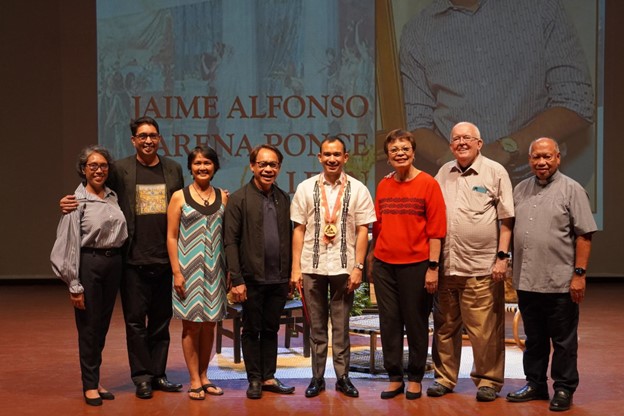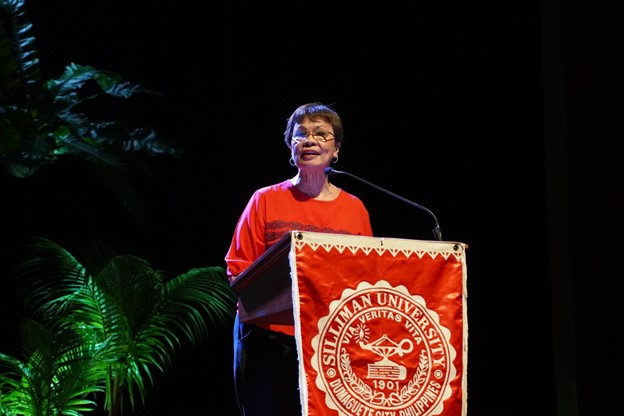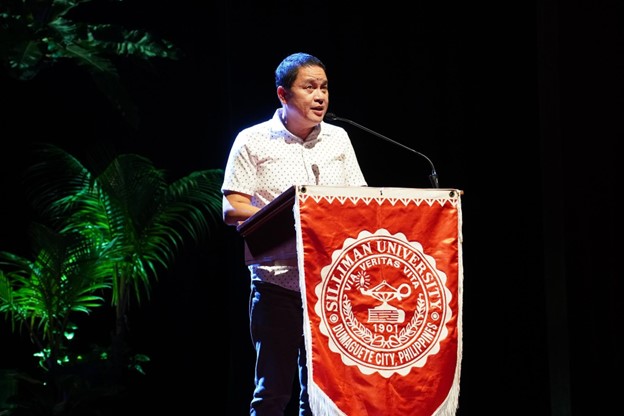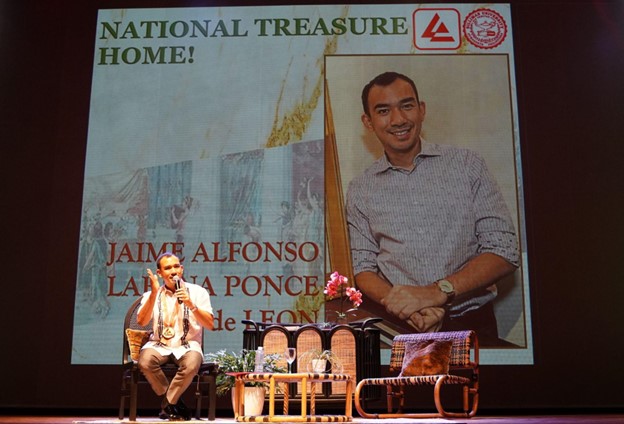
SU alumnus shares journey in bringing home Luna’s Hymen, oh Hyménée!

From left to right: Marie Christel R. Kho, Claire Isabel McGill Luce Auditorium manager; Moses Joshua B. Atega, International Students adviser; Dessa Quesada-Palm, YATTA director; Dr. Diomar C. Abrio, CAC chairperson; Jaime Alfonso “Popong” Ponce de Leon, art curator and founder/director of Leon Art Gallery; Dr. Betty Cernol McCann, SU president; Dennis McCann, husband of Dr. McCann; and Rev. Jonathan R. Pia, SU Church minister, pose after the event.
Silliman University (SU) alumnus Jaime Alfonso Larena Ponce de Leon visited the SU campus to share the journey in his search and discovery of Juan Luna’s masterpiece, Hymen, oh Hyménée! at the Claire Isabel McGill Luce Auditorium on March 1, 2024.
The forum also featured the short documentary film, “Hymen, oh Hyménée! – Juan Luna’s Long Lost Masterpiece,” released in 2023 and directed by Martin Arnaldo in partnership with the Ayala Museum in the Philippines.
After over a century of being hidden away from the public eye, not only among art collectors and enthusiasts but also among Filipinos, Luna’s painting was discovered by Ponce de Leon in 2014. Nine years later, it was unveiled at the Ayala Museum on June 9, 2023, in time for the Philippines’ 125th Independence Day.

Jaime Ponce de Leon answers some questions from the audience during the talk’s open forum.
A true red Sillimanian
Ponce de Leon is an auctioneer, art expert, and founder and director of the esteemed Leon Art Gallery, whose mission is “to make the best of Filipino art accessible to the world.”
The forum was dubbed as a “homecoming” not only for Luna’s long-lost masterpiece making its way back to its home country, the Philippines, but also for Ponce de Leon, whose visit also marked a homecoming of sorts to Dumaguete and the campus by the sea, his second home and alma mater since his Early Childhood years until he completed his degree in Bachelor of Science in Business Administration in 2003.
“How this all started was because of my classmate and very good friend Jae Ryl Moncada [SU Luce secretary] who kept reminding me to make sure this happens… [to share] this film and this honor with my alma mater. I’m really proud, of course, to be a Sillimanian,” Ponce de Leon said after Silliman University presented him with a certificate of appreciation for gracing the event.
“It is known to everyone in my field and in Manila where I’m based that I’m from Dumaguete and I’m from Silliman University,” Ponce de Leon added.

Dr. Betty Cernol McCann reflects on the afternoon’s theme of “coming home” as she welcomes back Sillimanian Jaime Ponce de Leon to SU.
Introducing Ponce de Leon in her speech, SU President Dr. Betty Cernol McCann welcomed back the alumnus and founder/director of Leon Art Gallery. She commended him for his magnanimity, pointing out that the event “is no ordinary homecoming. He came bearing a gift, sharing to us the captivating story of how a masterpiece of a national artist was recovered after more than a century of obscurity.”
“If you think about it, the theme this afternoon is “coming home,” Dr. McCann reflected as she addressed the crowd at the Luce Auditorium.
“The lost art of Juan Luna has returned to our country, providing ample opportunities for the Filipinos to marvel at the beauty of an artwork unsurpassed in its world-class caliber,” Dr. McCann added.
Dr. Earl Jude Paul L. Cleope, SU vice president for Academic Affairs (VPAA) also joined in welcoming Ponce de Leon, whose presence, Dr. Cleope pointed out, has made the event even more enriching.

Dr. Earl Jude Paul L. Cleope, SU VPAA, talks about the significance of the event.
“Today, we embark on a journey of discovery, tracing the captivating quest to find and acquire Juan Luna’s lost work, Hymen, oh Hyménée!, a masterpiece rediscovered after 132 years of obscurity,” Dr. Cleope said.
“Mr. Ponce de Leon’s passion for art has propelled him on an incredible adventure, shaping the local arts and culture scene. It is a rare opportunity to delve into the world of art discovery and preservation with one of the industry’s leading figures,” he added.
Unveiling Hymen, oh Hyménée!

Juan Luna’s Hymen, oh Hyménée! is displayed at the Ayala Museum in Makati, Philippines until March 24, 2024. Photo courtesy of the Ayala Museum on Facebook.
“The very reason why this exhibition even happened was because, in 2022, around sometime [in] October, Mariels Gustilo [Senior Director] of the Ayala Museum and Joanna Ongpin-Duarte [Senior Director] called me—because they wanted to raise funds for the Ayala Foundation—because of what I do. My business is auctions in Manila and I partner with a lot of institutions to raise funds for charity and all these things,” Jaime Ponce de Leon began, as he recounted his experience during the open forum.
“So when we had that lunch, they wanted to—they needed my help– for raising funds for the Foundation. Naturally, I would tell them, It’s tiring to look for things to sell, to look for people to donate things… So I thought of sharing with them the possibility of presenting something special, which is this,” he recalled.
At the time though, Ponce de Leon admitted he was not really prepared to lend them Juan Luna’s painting.

Jaime Ponce de Leon shares a candid moment with Moses Joshua B. Atega, Dr. Betty Cernol McCann, and her husband Dennis McCann.
“I had this painting since 2014. I had this painting since 2017 in Manila. It was just in a crate, just in my office, and no one knew what was contained in the crate, and my staff didn’t know what it was,” he confided.
After much convincing, Ponce de Leon decided to say yes to Ayala Museum, with the assurance that all proceeds go directly to where it’s intended—the Foundation. Something good had to come out of it, according to Ponce de Leon.
“About finding this painting, this painting has always been in the consciousness of anyone into collecting art. This painting has appeared in a lot of documentations, books of the 19th century. Anything that talks about Luna will always have this painting, but no one knew where it was,” he explained.
“There is this guy by the name of Dr. Eleuterio Pascual who was a very big collector. He was best friends with Mrs. Marcos. He would talk about this painting because there was a party that they went to in the 1970s in Spain in a beautiful palace, and they saw this painting. Of course, with the resources of the government they could have easily brought it with Mrs. Marcos. However, the owner of the painting wasn’t prepared [to let it go] because he was still alive. So everything involved timing also,” Ponce de Leon shared.
By the time Ponce de Leon was informed of the existence of the painting, the owner had already died.
“I think being at the right place and the right time played a big role in the acquisition of this painting. It also involved a lot of knocking [on the] homes of the nobility. I had to befriend the groom of the duchess of Alba, and all the royalty in Europe, just to be able to see this painting,” Ponce de Leon said.
Ponce de Leon revealed he was able to find other works by Luna in his search for Hymen, oh Hyménée! along the way, although Ponce de Leon would assess the latter one as Luna’s one of the very few significant ones.
“It involves so much work, so many trips, so much courage to just try everything to find it. And here it is now,” he added.
Juan Luna and the Philippines
Born in Badoc, Ilocos Norte, Philippines on October 23, 1857, Juan Luna y Novicio was born to the Cala Family of the Philippines, the third child of seven siblings. He went on to study and complete his Bachelor of Arts degree in Ateneo Municipal de Manila in 1874. He then moved on to the Escuela Nautica de Manila to become an apprentice officer, which allowed him to visit many places in Asia.
But Luna loved to paint. Coming home from Manila after his trips to Asia, he would take painting lessons at the Academia de Dibujo y Pintura (Academy of Drawing and Painting), known for being the first art school established in the Philippines in 1821.
Before the 1880s, “Filipino” was a term reserved for the people of Spanish parentage born in the Philippines. The “peninsular” referred to those of Spanish parentage and who were born in Spain. The “mestizo” referred to those born in a mixed Spanish and Filipino parentage. Finally, the Malayan native-born inhabitants of the Philippines were then called indio (also “indigenta”), the colonial racial term during the Spanish occupation. This class occupied the lowest level in a highly stratified class of society.
By the late 1880s to the 1890s, however, the term “Filipino” began to take on a different meaning, which referred to the “people of the Philippines,” with historians believing this change emerged because the peninsular Spaniard failed to distinguish between the mestizo and indio.
Luna rose to fame as a Filipino painter for his work, Spoliarium, a colossal masterpiece that won the gold prize at the renowned Madrid Art Exposition in 1884 and later on, for Hymen, oh Hyménée! which won the bronze prize at the Exposition Universelle in 1889 in Paris, France.
But Luna would face a grimmer and highly controversial reputation with the murder of his wife, Paz Pardo de Tavera y Gorricho, and mother-in-law, Doña Juliana Gorricho, one that would overshadow his entire career for years to come.
“Historians trying to decode the painting also referred to the turtle as Luna. You know the ending of Luna, right? You know what happened to Luna, and what happened to his wife and mother-in-law. He eventually–depending on which side of the story you hear–killed, in some accounts, his mother-in-law and wife out of jealousy. So the wife seems to be looking elsewhere, but Luna is there under the gutter. He viewed himself as that submissive figure in their lives,” he explained.
“Luna kept this painting up to the end of his life, probably still trying to give away a lot of meaning from this painting,” Ponce de Leon reflected.
All this set the backdrop for Juan Luna’s journey, and, more than a century later, the significance of this discovery.
“It was a triumph for the Filipino and with that it transcends so much pride for Filipinos to have won that award,” Ponce de Leon said.
Luna’s painting is on display at the Ayala Museum in Makati, Philippines until March 24, 2024. Ponce de Leon also encouraged the crowd to see the painting itself. After Ayala Museum, it might go to Singapore or other institutions.
Next holy grail?
When asked where the painting might eventually end up, Ponce de Leon said he doesn’t know yet, let alone if a monetary value can be put to it in the first place.
“As a dealer, sell? Maybe not. Maybe give to Silliman? I don’t know,” Ponce de Leon quipped.
So what’s the next holy grail for Ponce de Leon?
“Nothing can surpass this. Maybe People and Kings (in French, Peuple et Rois)? People and Kings is another work by Luna that is believed to have burned during the war, but who knows? It could probably be somewhere. We’re only as good as our last find. Or in my case, I’m only as good as my last auction. So everything has to be better, better, better. The work gets harder, harder, harder. So let’s see,” he said.
Among those present at the event include Foundation University, Negros Oriental State University, Colegio de Santa Catalina de Alejandria, Silliman University, Negros Oriental High School, National Museum of the Philippines Dumaguete, and City Mayor representative Atty. Karissa Tolentino-Maxino.
The SU Luce also thanked TESOL Coach Master Inc. for sponsoring 50 students from Foundation University and Negros Oriental National High School to attend the event, Vanessa Gaston for lending some furniture, and the Silliman University Culture and Arts Council (CAC).

Jaime Alfonso Larena Ponce de Leon answers more questions during the open forum.


